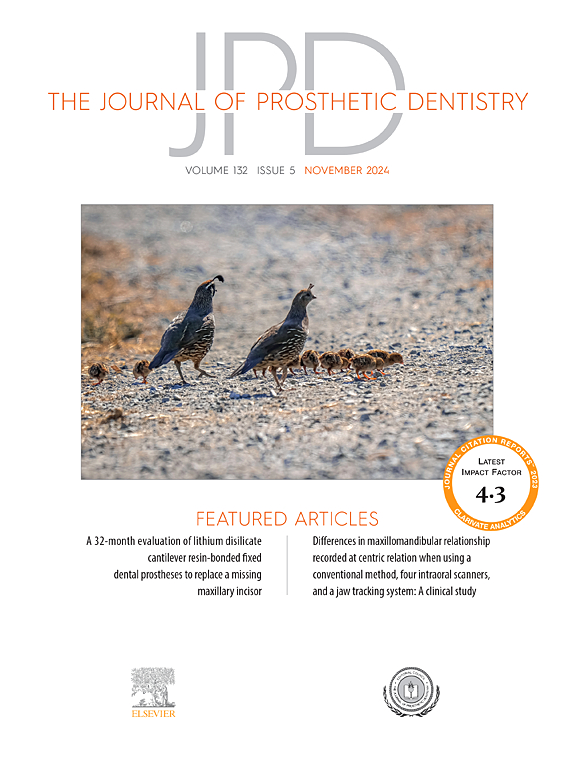An evaluation of quantitative percussion diagnostics for determining the probability of a microgap defect in restored and unrestored teeth: A prospective clinical study
IF 4.3
2区 医学
Q1 DENTISTRY, ORAL SURGERY & MEDICINE
引用次数: 0
Abstract
Statement of problem
Current dental diagnostics are image based and cannot detect a structural microgap defect such as a crack in a tooth. Whether percussion diagnostics can effectively diagnose a microgap defect is unclear.
Purpose
The purpose of the present study was to determine from a large multicenter prospective clinical study whether quantitative percussion diagnostics (QPD) could detect structural damage in teeth and whether a probability of its presence could be provided.
Material and methods
A nonrandomized prospective and multicenter clinical validation study with 224 participants was performed in 5 centers with 6 independent investigators. The study used QPD and the normal fit error to determine whether a microgap defect was present in a natural tooth. Teams 1 and 2 were blinded. Team 1 tested teeth scheduled for restoration with QPD, and Team 2 disassembled the teeth aided by a clinical microscope, transillumination, and a penetrant dye. Microgap defects were documented in written and video formats. Controls were participants without damaged teeth. The percussion response from each tooth was stored on a computer and analyzed. A total of 243 teeth were tested to provide approximately 95% power to test the performance goal of 70%, based on an assumed population overall agreement of 80%.
Results
Regardless of the collection method, tooth geometry, restoration material used, or restoration type, the data on detecting a microgap defect in a tooth were accurate. The data also reflected good sensitivity and specificity consistent with previously published clinical studies. The combined study data showed an overall agreement of 87.5% with a 95% confidence interval (84.2 to 90.3), beyond the 70% predetermined performance goal. The combined study data determined whether it was possible to predict the probability of a microgap defect.
Conclusions
The results showed that the data on detecting microgap defects in a tooth site were consistently accurate and confirmed that QPD provided information to aid the clinician in treatment planning and early preventative treatment. QPD can also alert the clinician of probable diagnosed and undiagnosed structural problems via the use of a probability curve.
定量叩诊诊断用于确定修复和未修复牙齿微间隙缺损概率的评估:一项前瞻性临床研究。
问题说明:目前的牙科诊断是基于图像的,不能检测结构微间隙缺陷,如牙齿裂缝。冲击诊断是否能有效诊断微间隙缺陷尚不清楚。目的:本研究的目的是通过一项大型多中心前瞻性临床研究来确定定量敲击诊断(QPD)是否可以检测牙齿结构损伤以及是否可以提供其存在的概率。材料和方法:一项非随机、前瞻性、多中心临床验证研究,在5个中心、6名独立研究者中进行了224名参与者。该研究使用QPD和正常拟合误差来确定天然牙齿是否存在微间隙缺陷。第1组和第2组被盲测。第一组使用QPD对牙齿进行测试,第二组使用临床显微镜、透照和渗透染料对牙齿进行拆卸。用书面和视频格式记录了微隙缺陷。对照组是没有牙齿受损的参与者。每颗牙齿的撞击反应被储存在计算机上并进行分析。总共测试了243颗牙齿,在假定人口总体同意率为80%的基础上,提供大约95%的功率来测试70%的性能目标。结果:无论采集方法、牙体几何形状、修复材料、修复类型如何,检测牙体微间隙缺损的数据都是准确的。数据还反映了良好的敏感性和特异性,与先前发表的临床研究一致。综合研究数据显示,总体一致性为87.5%,95%置信区间(84.2至90.3),超出了70%的预定性能目标。综合研究数据确定是否有可能预测微间隙缺陷的概率。结论:QPD检测牙位微间隙缺陷的数据一致准确,为临床医生制定治疗计划和早期预防治疗提供了信息。QPD还可以通过使用概率曲线提醒临床医生可能诊断和未诊断的结构问题。
本文章由计算机程序翻译,如有差异,请以英文原文为准。
求助全文
约1分钟内获得全文
求助全文
来源期刊

Journal of Prosthetic Dentistry
医学-牙科与口腔外科
CiteScore
7.00
自引率
13.00%
发文量
599
审稿时长
69 days
期刊介绍:
The Journal of Prosthetic Dentistry is the leading professional journal devoted exclusively to prosthetic and restorative dentistry. The Journal is the official publication for 24 leading U.S. international prosthodontic organizations. The monthly publication features timely, original peer-reviewed articles on the newest techniques, dental materials, and research findings. The Journal serves prosthodontists and dentists in advanced practice, and features color photos that illustrate many step-by-step procedures. The Journal of Prosthetic Dentistry is included in Index Medicus and CINAHL.
 求助内容:
求助内容: 应助结果提醒方式:
应助结果提醒方式:


